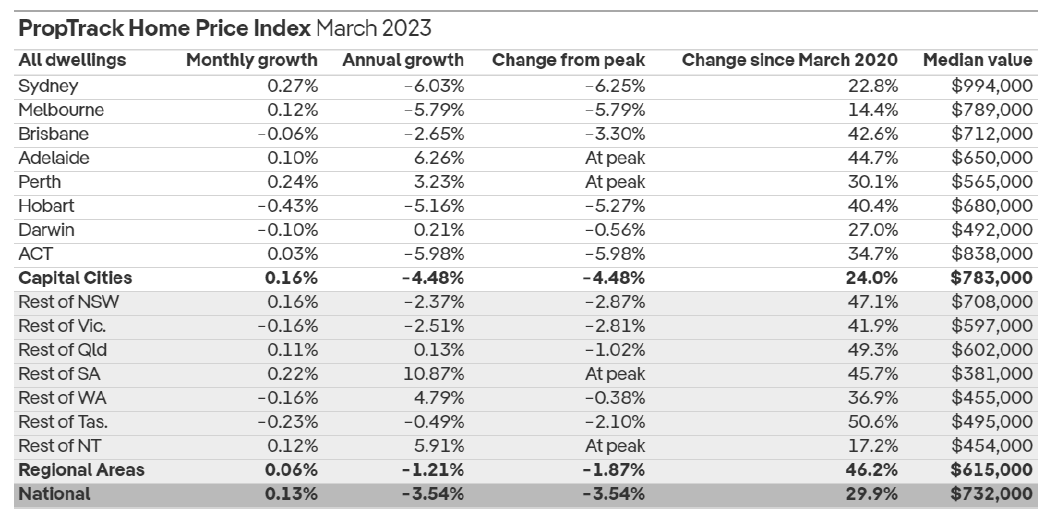

Australian home prices have reversed their downward trend, with prices increasing for a third consecutive month in March, as limited supply and strong demand continue to insulate prices.
This was according to the PropTrack Home Price Index, which found that home prices rose 0.13% nationally in March, with all capital cities aside from Brisbane, Hobart, and Darwin recording increases. House prices have increased by a total of 0.49% so far this year.
Recording the largest jump in prices was Sydney with a +0.27% rise, followed by Perth, with +0.24%, and Melbourne, with +0.12%. Prices in Adelaide and Canberra also increased by +0.1% and +0.03%, respectively. Hobart (-0.43%), Brisbane (-0.06%), and Darwin (-0.1%) were the only capital cities to post declines.
While home prices have dropped from their peak in most markets, prices nationally were still 29.9% above their pre-pandemic levels.

“While the significant reduction in borrowing capacities and deterioration in affordability caused by interest rate rises implies larger price falls, the impact of rate rises is being counterbalanced,” said Eleanor Creagh (pictured above), PropTrack senior economist and report author. “Positive demand drivers offsetting the downwards pressure include the strong rebound in immigration, tight rental markets, and (slowly) increasing wages growth. The sustained softness in new listing volumes is also keeping a floor under prices.”
Creagh said home prices will stabilise further if the Reserve Bank pauses its tightening cycle this month or the next. This, in turn, will ease some of the uncertainty buyers have experienced with respect to borrowing capacities and may also boost confidence.
“Despite the latest monthly inflation read providing further evidence inflation may have peaked in December and indicating cost pressures are easing as the tightening already pushed through is taking effect, inflation remains elevated and is well above the Reserve Bank’s 2-3% target range,” she said.
“Together with the lift in employment seen in the most recent update on the labour force, the labour market remains tight. This is giving the RBA headroom to further raise the cash rate next week.”
Creagh is expecting the Reserve Bank to lift the cash rate by 25 basis points to 3.85% this week but said that “it’s a close call and the end of interest rate rises is in sight, whether the Reserve Bank [will] pause this month or next.”
“This would likely be the point at which the RBA pauses its tightening cycle and assesses the impact of the tightening already delivered,” she said.
“There is evidence that the substantial tightening pushed through in a short period is weighing on households. Further, it takes time for higher interest rates to fully impact household cash flows. In this tightening cycle, with so many borrowers having taken advantage of record-low fixed-rate mortgages throughout the COVID period yet to feel the full impact of rate rises, this is especially the case. As such, it is expected that consumer spending will slow sharply over the coming months as the lagged impact of rate rises already delivered takes effect.
“This is leading some to speculate that an earlier pause is on the cards in April, giving the RBA more time to assess the full impact of rate rises already delivered on households, businesses, and economic conditions.”
Use the comment section below to tell us how you felt about this story.
